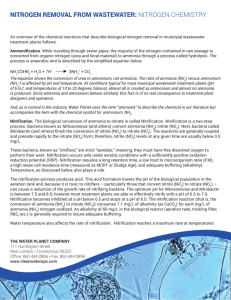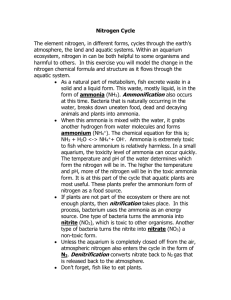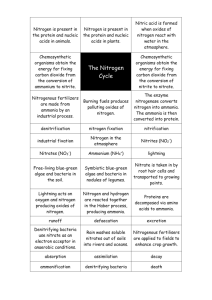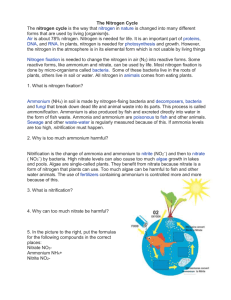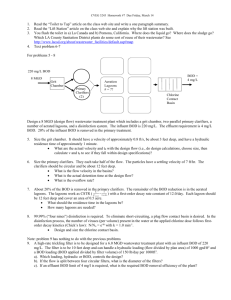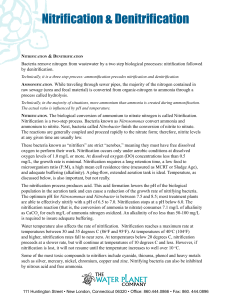Nitrogen Removal from Wastewater: A Primer
advertisement
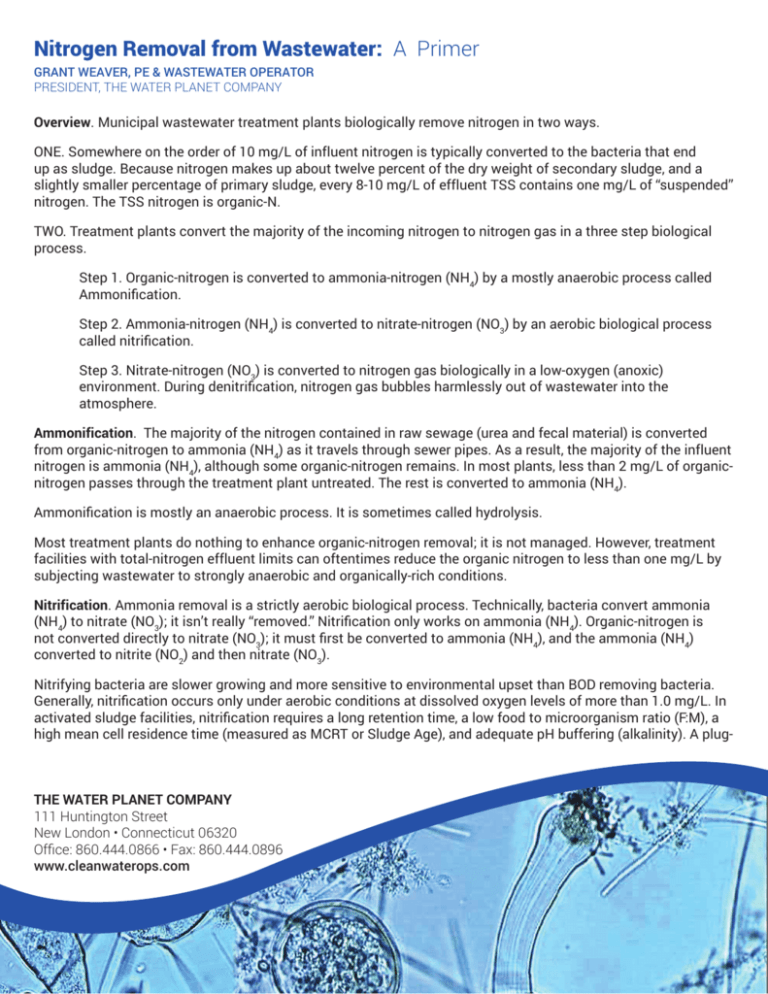
Nitrogen Removal from Wastewater: A Primer GRANT WEAVER, PE & WASTEWATER OPERATOR PRESIDENT, THE WATER PLANET COMPANY Overview. Municipal wastewater treatment plants biologically remove nitrogen in two ways. ONE. Somewhere on the order of 10 mg/L of influent nitrogen is typically converted to the bacteria that end up as sludge. Because nitrogen makes up about twelve percent of the dry weight of secondary sludge, and a slightly smaller percentage of primary sludge, every 8-10 mg/L of effluent TSS contains one mg/L of “suspended” nitrogen. The TSS nitrogen is organic-N. TWO. Treatment plants convert the majority of the incoming nitrogen to nitrogen gas in a three step biological process. Step 1. Organic-nitrogen is converted to ammonia-nitrogen (NH4) by a mostly anaerobic process called Ammonification. Step 2. Ammonia-nitrogen (NH4) is converted to nitrate-nitrogen (NO3) by an aerobic biological process called nitrification. Step 3. Nitrate-nitrogen (NO3) is converted to nitrogen gas biologically in a low-oxygen (anoxic) environment. During denitrification, nitrogen gas bubbles harmlessly out of wastewater into the atmosphere. Ammonification. The majority of the nitrogen contained in raw sewage (urea and fecal material) is converted from organic-nitrogen to ammonia (NH4) as it travels through sewer pipes. As a result, the majority of the influent nitrogen is ammonia (NH4), although some organic-nitrogen remains. In most plants, less than 2 mg/L of organicnitrogen passes through the treatment plant untreated. The rest is converted to ammonia (NH4). Ammonification is mostly an anaerobic process. It is sometimes called hydrolysis. Most treatment plants do nothing to enhance organic-nitrogen removal; it is not managed. However, treatment facilities with total-nitrogen effluent limits can oftentimes reduce the organic nitrogen to less than one mg/L by subjecting wastewater to strongly anaerobic and organically-rich conditions. Nitrification. Ammonia removal is a strictly aerobic biological process. Technically, bacteria convert ammonia (NH4) to nitrate (NO3); it isn’t really “removed.” Nitrification only works on ammonia (NH4). Organic-nitrogen is not converted directly to nitrate (NO3); it must first be converted to ammonia (NH4), and the ammonia (NH4) converted to nitrite (NO2) and then nitrate (NO3). Nitrifying bacteria are slower growing and more sensitive to environmental upset than BOD removing bacteria. Generally, nitrification occurs only under aerobic conditions at dissolved oxygen levels of more than 1.0 mg/L. In activated sludge facilities, nitrification requires a long retention time, a low food to microorganism ratio (F:M), a high mean cell residence time (measured as MCRT or Sludge Age), and adequate pH buffering (alkalinity). A plug- THE WATER PLANET COMPANY 111 Huntington Street New London • Connecticut 06320 Office: 860.444.0866 • Fax: 860.444.0896 www.cleanwaterops.com Nitrogen Removal from Wastewater: A Primer GRANT WEAVER, PE & WASTEWATER OPERATOR PRESIDENT, THE WATER PLANET COMPANY flow, extended aeration tank is ideal. In trickling filter plants, it is generally best to operate in series with BOD removal in the first trickling filter and ammonia (NH4) removal in the second filter. The nitrification process produces acid. The acid lowers the pH of the biological population and is – unless buffered – toxic to the nitrifying bacteria. An aeration tank (or trickling filter) alkalinity of at least 60 mg/L is generally required. If there isn’t enough alkalinity present in the wastewater, bacteria will not complete the nitrification process; nearly all of the ammonia (NH4) will be converted to nitrite (NO2) but not all of the nitrite (NO2) will be converted to nitrate (NO3). At concentrations of more than 0.5 mg/L nitrite (NO2) can interfere with chlorine disinfection. At concentrations of a few milligrams per liter, nitrite (NO2) can exhibit toxicity and provide process upsets. Water temperature also affects the rate of nitrification. At temperatures below 20 degrees C, nitrification proceeds at a slower rate, but will continue at temperatures below 10oC. However, if nitrification is lost, it will not resume until the temperature increases to well over 10oC. Denitrification. Wastewater cannot be denitrified unless it is first nitrified. The biological reduction of nitrate (NO3) to nitrogen gas is performed by bacteria that live in a low-oxygen environment. To thrive, the bacteria need BOD – soluble BOD. Particulate BOD needs to be broken down into solution before it is of value. Denitrifying organisms are generally less sensitive to toxic chemicals than nitrifiers, and recover from toxic shock loads quicker than nitrifiers. However, most facilities have more difficulty with nitrate (NO3) removal (denitrification) than ammonia (NH4) removal (nitrification) for two principal reasons. At low temperatures, it becomes more difficult to drive down the dissolved oxygen concentration and keep the ORP values at desired negative millivolt levels. Variations in BOD loadings also make it difficult to maintain consistent nitrate (NO3) removal. Denitrifying bacteria require a considerable amount of soluble BOD (some five times as much as the amount of nitrate (NO3) being denitrified) and many facilities find it difficult to provide an ongoing supply of readily digestible BOD. THE WATER PLANET COMPANY 111 Huntington Street New London • Connecticut 06320 Office: 860.444.0866 • Fax: 860.444.0896 www.cleanwaterops.com
